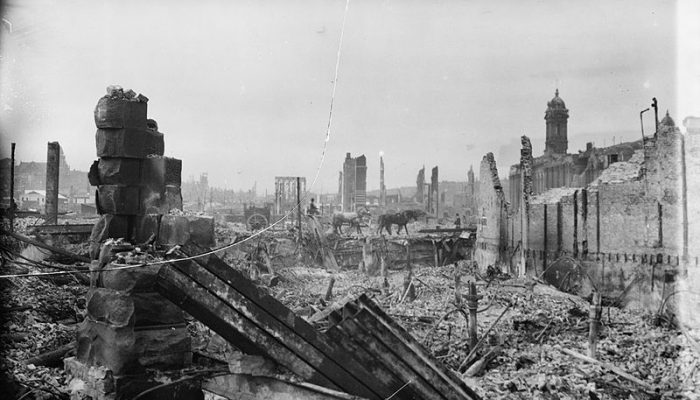
Each month, Jesse Zondervan picks his favourite posts from geoscience and development blogs/news which cover the geology for global development interest. Here’s a round-up of Jesse’s selections for the last month:
California seems to be overdue for earthquakes, meaning there has been a so-called earthquake ‘drought’ in the last century. Paleoseismic studies show that this hiatus is unprecedented in the last ten centuries. This means we might see a high frequency of earthquakes coming this century, while a generation who hasn’t experienced any major earthquake has passed.
Furthermore, a related article in the San Francisco Chronicle reports the US Geological Survey projects a major quake along the San Andreas Fault would cause more than 98 billion in building damage and kill up to 7,800 people. The main threat, however, is the aftermath with loss of power for at least three days and half of households without water for at least a month. The study highlights the importance of preparing the population for a quake and its aftermath.
Fortunately, this month also saw the publication of a Californian record of two million tiny earthquakes detected by Caltech scientists. This tenfold increase in the earthquake catalogue tells them more about how faults and earthquakes work and get triggered. Greg Beroza, a Stanford University seismologist says “It’s just like if a new telescope comes along and its magnification is 10 times greater”.
Can climate-change induced flooding increase inequality?
The answer seems to be yes, in fact it does. A report published by the Urban Institute in the US showed that people with poor credit scores suffered bigger drops in scores than those starting with high scores. While home-owners receive insurance pay-outs, costs to renters only increase due to increased demand after major storms.
Consequently, social vulnerability should be considered when risk is modelled and funding allocated, according to RMS flood specialist Nicole Howe.
More perspectives this month on the aftermath and lessons from Cyclone Idai which struck southern Africa in March; the challenge of religious resignation to building resilience against natural hazards in Indonesia and what the new bill on the US National Volcano Warning System means to disaster risk reduction.
Go ahead and look through this month’s picks!
Aftermath and Response to Cyclone Idai
Cyclone Idai shows why long-term disaster resilience is so crucial by Channing Arndt and Claudia Ringler at The Conversation
Cyclone Idai is over – but its health effects will be felt for a long time by Kerrigan McCarthy and Lucille Blumberg at The Conversation
Responding To Cyclone Idai requires a more robust approach by Peter Kamalingin at Oxfam International
Earthquake risk in California
Reassessing California’s Overdue Earthquake Tab by Mary Caperton Morton at Eos Earth & Space Science News
What a major earthquake would do to San Francisco by Kimberley Veklerov at the San Francisco Chronicle
Scientists Uncover California’s Hidden Earthquakes by Shannon Hall at Scientific American
Flooding and inequality
How natural disasters can increase inequality by Gretchen Frazee at PBS
States are turning to data and interactive maps to help residents confront and manage flood risks by Shannon Cunniff at the Environmental Defense Fund (EDF)
Disaster Risk Reduction: Avoiding the Inevitable by Nicola Howe at RMS
New York’s Poor and Ethnic Minority Neighbourhoods to be hit hardest by Climate Change finds NYC Panel on Climate Change by Will Bugler at Acclimatise
Climate Adaptation
7 American cities that could disappear by 2100 by Aria Bendix at Business Insider
Improving Water Resources Management with Satellite Data by Aaron Sidder at EOS Earth and Space Science News
Central America: Climate, Drought, Migration and the Border by Lieutenant Commander Oliver-Leighton Barrett at The Center for Climate & Security
Disaster Risk Reduction
Living with natural disasters – how to change Indonesia’s culture of passive resignation by Juliana Wijaya at The Conversation
Major geological survey hopes to make Indonesia more resistant to deadly tsunamis by Tim Pilgrim at Brunel University London
Hurricane Harvey provides lessons learned for flood resiliency plans at ScienceDaily
US National Volcano Warning System Gains Steam by Forrest Lewis at Eos Earth & Space Science News
External Opportunities
Register for Science and Policy Forum of 2019 Global Platform for DRR at Integrated Research on Disaster Risk (IRDR)
The Art of Resilience – Call for art helping build society’s resilience to natural hazards at GFDRR
Register to attend or watch online – Disasters: impact on child poverty and development at the Overseas Development Institute
Teaching Assistantship Applications Open for Sustainable Development Undergraduate Courses at the Earth Institute, Columbia University
Summer 2019 Teaching Assistantship Available in Environmental Science and Policy Program at the Earth Institute, Columbia University
Check back next month for more picks!
Follow Jesse Zondervan @JesseZondervan. Follow us @Geo_Dev & Facebook.



